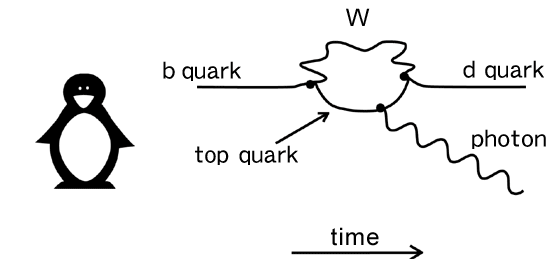Quarks are the most fundamental constituents of material, and it is widely known that six types exist in nature. The purpose of the B Factory is to produce an enormous number of the second heaviest, called the bottom quark, and clarify the fundamental laws of the universe by detailed studies of its behavior. The international experimental group called Belle has been carrying out these studies at KEKB, the electron-positron colliding beam accelerator at KEK in Tsukuba, Japan, and has made many important contributions to our understanding of nature at its most fundamental level. These include the discovery of the violation of particle-antiparticle symmetry in bottom quark decays, the experimental confirmation of the Kobayashi-Maskawa theory that predicted this symmetry violation, and the discovery of many new particle states.
In the last year, the performance of the KEKB accelerator has continued to improve, reaching the world's highest luminosity of 1.5x1034 /cm2/sec, and delivering 390 million pairs of B and anti-B mesons to the Belle experiment. (These mesons contain the bottom quark or its antiparticle.) Belle group has investigated the decays of these B mesons in detail, and has observed a new type of interaction wherein the bottom quark turns into one of the lightest quarks, the down quark. This phenomenon was confirmed by finding 35 events where the B meson decays into either a rho or an omega meson with an accompanying photon, and 30 events where the B meson disintegrates into two K mesons.
This type of interaction is predicted in the standard model of elementary particles. Its rarity, according to the parameters of the successful Kobayashi-Maskawa formulation, is attributed to the constraint that the bottom quark transform into a down quark via a two-step transition---a so-called ``penguin process.'' The low probability explains why no evidence for the b -> d+gamma process has been observed in previous experiments.
Observation of this very rare phenomenon allows us to study if this occurs only through the penguin process as predicted by the standard theory, or through some hitherto unobserved way. This opens an exciting new window into our understanding of elementary particle physics: for example, new physics models that incorporate so-called supersymmetry also predict bottom to down quark transitions, and our announced observation will provide valuable feedback to these models. On the other hand, if we assume that the standard model holds, then our observation will provide a novel measurement of Vtd, one of the parameters in the Kobayashi-Maskawa theory, and lead to a more complete understanding of the standard model.
The new results have been announced at the Symposium on Lepton Photon Interactions at High Energies to be held in Uppsala, Sweden between June 30 and July 5.
 |
| Figure 1 : It was proven that B meson decays into a lighter meson such as rho or omega with an accompanying photon. This is an evidence for b -> d transition. |
 |
| Figure 2 : It was also confirmed that B meson disintegrates into two K mesons with a probability of the order of 10-6. This is also an evidence for b -> d transition. |
 |
| Figure 3 : In the standard theory of elementary particles, b quark turns into a pair of a W particle and a top quark for a very short time, which causes a transition from b quark to d quark. This process is sometimes called a "penguin process". |
|



